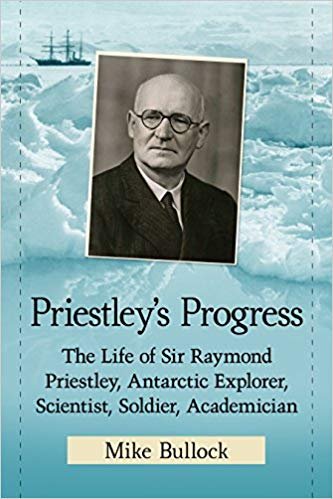Priestley’s Progress: The Life of Sir Raymond Priestley, Antarctic Explorer, Scientist, Soldier, Academician
Mike Bullock
 Priestley’s Progress, by Mike Bullock, is an examination of Sir Raymond Priestley’s eclectic life, from his early childhood to numerous expeditions and World War I service, all lending to life examples he brought to his teachings throughout his academic career. Targeted towards academics, explorers, and historians, Bullock presents the book in a chronological context that aims to provide examples of the impact made by Priestley in the areas of exploration, science, and academia during the early twentieth century.
Priestley’s Progress, by Mike Bullock, is an examination of Sir Raymond Priestley’s eclectic life, from his early childhood to numerous expeditions and World War I service, all lending to life examples he brought to his teachings throughout his academic career. Targeted towards academics, explorers, and historians, Bullock presents the book in a chronological context that aims to provide examples of the impact made by Priestley in the areas of exploration, science, and academia during the early twentieth century.
Born in Tewkesbury, England in 1886, Raymond Priestly grew up amongst many siblings with educated parents, his father being a headmaster. Striving towards a similar goal, Priestley attended University College, Bristol during which he was sought after by Sir Ernest Shackleton, an explorer based in London. With some hesitation, Priestley agreed and began his career as an Antarctic explorer, during which time he would have many life endangering experiences full of adventure and excitement. From 1907 to 1909, Raymond Priestley traveled on Nimrod, studying geographical features of the Antarctic. During this exploration, the crew was plagued by lack of food, extreme temperatures, and loss of navigation, making their goal of reaching the pole an initial failure. In 1910, Priestley began his second exploration, this time aboard Terra Novaalongside Robert Scott, and was met by many more successes.
Priestley also had accomplishments during his military career. Entering World War I in the British Army Signal Service, Priestley joined the Cambridge University Officers Training Corps in 1913. Here, he utilized the first wireless telegraph set to communicate until the end of his career in 1919, during which he was presented with a Military Cross for gallantry. After the war, Priestley returned to London and began a more narrowed focus on academia, teaching at Cambridge, Melbourne, and Birmingham; however, the passion for exploration ignited once again during his retirement. Priestley traveled on Wyandotwith the Duke of Edinburgh for the American Deep Freeze IV Expedition in 1958 and his work there nominated him to become the President of the Royal Geographic Society. Priestly passed away of natural causes on June 24, 1974 at the age of eighty-eight.
Bullock’s biographical depiction of Priestley’s life is one of the first representations of this extraordinary man and his achievements.Priestley’s Progress presents a chronological outline of this explorer’s life, while Bullock condenses vast knowledge into a format that both informs readers and provokes curiosity for further detail. While the overall timeline is impressive, the book is filled with short descriptions of events and sporadic reminders of dates, time frames, and ages for Priestley during his adventures. Furthermore, the Preface references accounts and direct testimonies made by friends and family that would lend immensely to the appeal of a biographical work, yet citations remain sparse throughout the text and leave readers wanting to know more of the background story to Priestley’s accomplishments.
Overall, Bullock offers a biographical exploration of Raymond Priestley that encompasses his full lifetime in a concise manner. The book is enjoyable and thought provoking, and may well encourage readers to seekadditional material on both Priestly and the exploration of Antarctica.
- Jefferson, North Carolina: McFarland & Company, 2017
- 7” x 10”, softcover, ix + 259 pages
- Photographs, notes, bibliography, index. $39.95
- ISBN: 9780786478057
Reviewed by Kelsey Dwyer, East Carolina University
